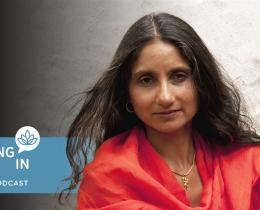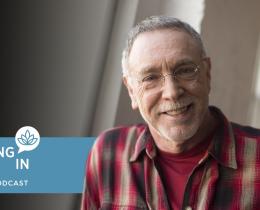ARTICLE

A Journey of Spiritual Music Across Generations
From the Hudson Valley to Kolkata, two men, a generation apart, connect in a tradition that has entranced Omega audiences and lovers of bansuri flute and North Indian classical music for years.
Bansuri flute masters Steve Gorn and Eric Fraser perform in Omega's Sanctuary on September 26, 2018.
Steve Gorn was one of a new wave of Westerners looking toward India when he first ventured there in 1969. Born into a musical family—his father was a classical pianist—Steve was immersed in the modern jazz world of the 1960s, but he was hungry to expand his musical vocabulary. Traveling through India, he arrived in Kolkata (then known as Calcutta) where he met bansuri flute master Sri Gour Goswami who drew him into the classical North Indian music of the era and set him on his path.
“At that time, India was not yet affected by speed, by the rush of time, like it is today,” he explains. “I am so fortunate to have witnessed a world that had yet to become truly modern.”
Learning the Mysteries of the Bansuri
Sri Gour Goswami became Steve Gorn’s teacher, guiding him into the vocal (gayaki) style of the bansuri, an old world rendering of raga—a pattern of notes having characteristic intervals, rhythms, and embellishments, with a focus on attention to the raga—the color of each note and melodic contour. In the early 1970s, when Steve was a couple of years into his studies, he met a young Bengali man named Gopal Roy, another of Sri Gour Goswami's students who was learning the gayaki style of raga. Their paths wouldn't cross again for another 30 years.
When Steve returned home after four years of travel, he was eager to infuse the world of Western jazz with Indian and African music. He began performing widely, building a career that, nearly 50 years later, encompasses projects from films scores to dance performances and an international reputation that has become synonymous with World Music.
“I have received such a gift from India, from the people who taught me,” explains Steve who, since 1996, has continued his studies with bansuri master Pandit Raghunath Seth of Mumbai. “I’m always looking for ways to offer it in different musical contexts.”
One of those contexts is at Omega, where he has been accompanying yoga and dance performances and giving concerts since the mid-1980s. For the past 14 years, he has also performed at the annual Ecstatic Chant, a weekend of musical prayer and meditation with some of the world’s most inspiring devotional singers and musicians.
Two Generations of American Bansuri Students Connect
Steve Gorn's teacher Sri Gour Goswami died in 1976, the same year that Eric Fraser was born. Toward the end of 1999, after studying philosophy at Bard College, Eric traveled to India to learn more about yoga, meditation, and kirtan (devotional chanting), which he encountered while working as a member of Omega’s seasonal community. It was on that first trip that he heard a bansuri flute player in a restaurant in Benares. Intrigued, he took a few lessons, first with the performer from the restaurant and then from a professor in the music department of Banara Hindu University.
Eric left India to come home, work, and save enough money to return and live in Kolkata for six months. A mecca for artists and writers, he was drawn to the city and wanted to immerse himself in its culture. He also wanted to study classical North Indian music, so he did his research and put out the feelers that eventually led him to Gopal Roy, the former student of Sri Gour Goswami and peer to Steve.
But before Eric returned to India in 2002, he had also reached out to Steve, who lived nearby, and began taking lessons with him.
“I wanted a proper teacher here, so I sent him an audio tape of my playing, not really believing that such a famous musician would respond to me,” he said. “I was so pleased by his warmth and responsiveness.”
When Eric told Steve about his plan to study in Kolkata with Gopal Roy, it woke a distant memory of the young man Steve had met 30 years earlier. Writing to Gopal Roy, Steve helped pave the way for Eric to study and live with him and his family.
Tuning In to Each Other Through Listening
“Gopal Roy's teacher was my teacher, so we both learned to move through pieces with a similar gahrana, with the same instinctual knowledge,” Steve Gorn explains. “Although raga follows a strict grammar, it also serves as the basis for improvisation that, in that tradition, unfolds timelessly. Indian musicians want you to find your own authenticity within a tradition and Eric Fraser plays quite differently than I do. But our styles are complementary and have common threads within that.”
“We really listen to each other when we play,” Eric adds. “Indian music is so rooted in the tunefulness of a note—the microtones. When the ear and mind become attuned to these shrutis, something opens up. It’s almost like a scent, the way it feels in the body, heart, and mind.”
Eric, who is a multi-instrumentalist, composer, educator, and professor of music therapy at SUNY New Paltz, first performed with Steve at Omega in 2005 as a background musician. Although their relationship grew gradually from that of student-teacher to colleagues, there was a turning point in 2011 when Eric was in Kolkata on a Fulbright scholarship and Steve passed through and witnessed how Eric lived with, and sounded like, his teacher Gopal. Since then, they continue to perform together, rooted in raga and grounded in the values and aesthetic of the slowly unfolding vocals of the gayaki-ang style.
“It’s a buzz phrase, but true,” Eric says. “Some people use raga to show off their skills. Others use their skills to show off raga. That’s us.”


